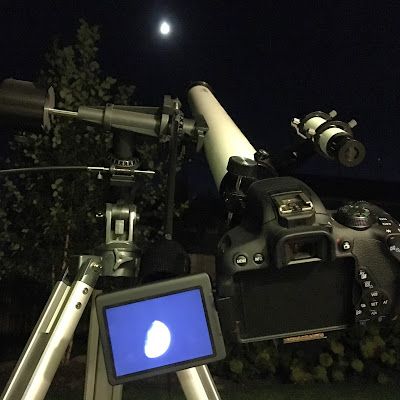As I've noted before, the hardest part of photographing the moon at prime focus with my Meade 285 refractor is the clunky focusing wheel on the telescope. The focuser is plastic, and there is no fine focus adjustment. So, as you can imagine, when looking at the LCD screen on the back of the camera and adjusting the focus, it's nearly impossible to tell when I'm actually in focus... Whenever I touch the telescope the image jumps all over.
With all that in mind, the advantages to prime focus are that you get a much larger image (and therefore higher number of pixels in the diameter of the moon) compared to just a 300mm camera lens. Prime focus definitely has the potential upper hand, but a major handicap when it comes to focusing - whereas the camera lens has incredible hands-free focus, but the moon is only projected onto a tiny area in the center of the image sensor and thus a smaller diameter in real pixels.
I took the images below on Sunday, September 11, 2016.
 |
| Click to enlarge, prime focus vs 300mm camera lens |
 |
| Stack of 10 frames, Canon T5i at 300mm, ISO 100, f/9, 1/160 sec with High Pass layer in Photoshop |
 |
| Stack of 17 frames, Canon T5i prime on Meade 285, ISO 400, 1/250 sec, 900mm with High Pass layer in Photoshop and Exposure +1.0 in Adobe Camera RAW |
 |
| From my perspective on the patio |
During my observing session, I also saw the rings of Saturn through the Meade 285, which is always a treat - even though it is insanely frustrating to try to position this old mount that doesn't want to stay put once you have your target. I also tried several times to get my iPhone mounted on the eyepiece to take a video of Saturn, but the mount is just too finicky and shifty.
Finally, I took this quick timelapse video of my prime setup using the app Hyperlapse, which is convenient when you don't know how much you will want to end up speeding up the final video. Unlike the other timelapse apps where you have to set the speed at the beginning.
No comments:
Post a Comment